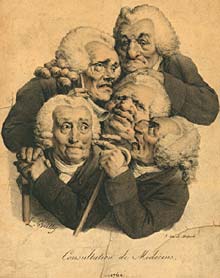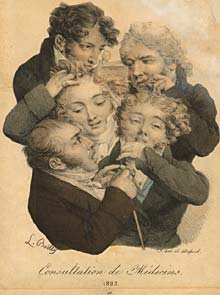French Caricature: Medical Caricatures or Political Commentary?
Depicting either inept or helpless doctors was a common subject for caricaturists. But sometimes, medical caricatures in the early nineteenth century held another layer of meaning. A print might on the surface poke fun at doctors busily consulting with each other while neglecting their patient in the background, but it could also be a medium for the artist to convey a political message about a suffering country being mismanaged by ineffective rule. The use of medical consultations in caricatures was not restricted to any particular political side, but was used by both French royalists and anti-royalists.14
According to art historian Nina Maria Athanassoglou-Kallmyer, Louis-Léopold Boilly’s lithograph, “Consultation de Médecins 1760,” is more than a dim view of the state of medicine in 1760. The five aged medical consultants, who are past their prime, given the ear horn, walking canes, and bewildered looks, are also a jab at the Ancien Régime, the social and political system established in France under the old absolute monarchy and subsequently eliminated by the revolution of 1789. Athanassoglou-Kallmyer explains:
A tightly knit cluster of old and impotent physicians wearing elaborate powdered wigs shouts (to overcome deafness) and quarrels fiercely in a confused and ineffective dialogue de sourds [dialogue of the deaf]. The eighteenth-century date in the caption and the eighteenth-century look of the figures suggest that this is an evocation, unflattering and chaotic, of the Ancien Régime.15
Louis-Léopold Boilly has a second lithograph entitled, “Consultation de Médecins, 1823.” Like the 1760 “Consultation de Médecins” and the next image of hunchbacks, this is a print from Boilly’s most popular series, “Recueil de grimaces” or “Collection of grimaces.” Containing over 90 lithographs, the series was published between 1823 and 1828. The members of this tightly grouped quintet, shown in 1823, are at the prime of life unlike Boilly’s aged medical consultants of 1760. These consultants are all young, but distinctive in their facial expressions. The physician in the lower left looks decidedly dismayed while the man next to him seems dreamy or even drugged. The two at the top appear to be engaged in academic pursuits. The magnifying glass indicates a scientific approach to medicine, and the gentleman in the upper right has a contemplative look as if he were trying to come up with a solution to a troubling problem. The viewer is left to decide if Boilly is making a political commentary about France in 1823, but could it be that the more things change, the more they stay the same?

